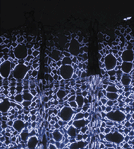Developmental Stages and Fine Structure of Surface Callus Formed after Debarking of Living Lime Trees (Tilia sp.)

Xylem as a source of cells for sealing wounds
The ability of plants to renew growth in response to damage is well-known. Growth may be renewed very quickly to replace lost tissue (as anyone who mows a lawn will know) and developmental pathways may be diverted to replace organs that have been removed. At the local level, smaller wounds are sealed by proliferation of cells around the wound site, often in association with the production of phenolic compounds that act as disinfectants. However, despite the widespread occurrence and importance of these phenomena, our knowledge of the detail is in many cases rather hazy. We need to know more about the signalling pathways, the re-allocation of cell and organ identities and the switches of gene expression that are involved in these processes. In some instances we do not know which cells participate and it just such a situation that has been investigated by Stobbe and colleagues at Hamburg (pp. 773-782). When a patch of bark is removed from a tree the wound is healed by the formation of a callus which differentiates into periderm. It is often assumed that the initial callus is derived from the cambium that underlies the bark. However, the authors' careful study of wound callus formation in lime (Tilia) shows that this is not so. Instead, the callus is derived from the outer layers of the xylem that have not yet undergone secondary thickening. After the callus has differentiated into the three-layered periderm a new cambium is formed between the periderm and the remaining xylem. This wound-healing process in Tilia thus starts with a dedifferentiation and re-programming of cells that were en route to becoming thickened vascular tissue. And what of the original cambium? If any remains at the wound surface after bark removal it does not contribute to callus formation; instead these the cells simply collapse and die.
Professor J. A. Bryant
University of Exeter, UK
j.a.bryant{at}exeter.ac.uk